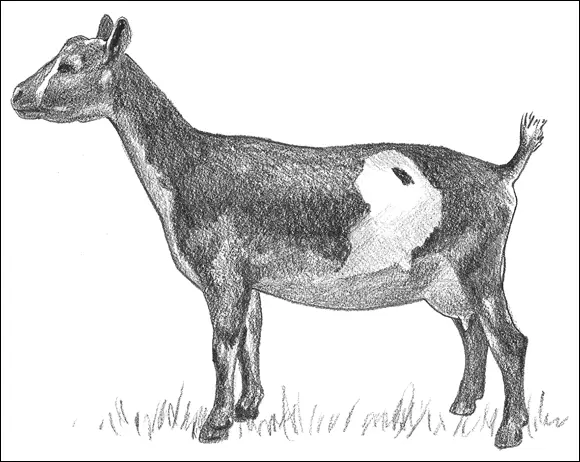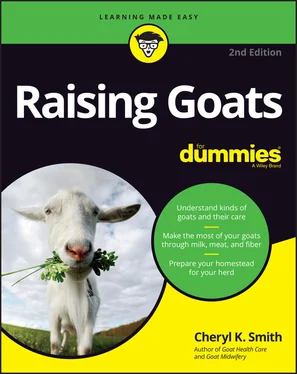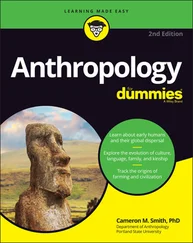LITTLE GOAT, A LOT OF CHEESE
My first goats were Nigerians. Their milk was high in protein and extremely high in butterfat — normally 5 to 6 percent and as high as 10 percent at the end of their lactation (normally 10 months). This higher butterfat milk produces more cheese than milk with low butterfat.
I did a comparison between the milk of a Toggenburg and a Nigerian and found that I got twice as much cheese from the Nigerian milk!
At least one goat cheese dairy in the United States uses Nigerians exclusively because of the quantity of cheese they can produce. You have to milk more goats to get the same quantity of milk you would from standard dairy goats, but you can get a lot more cheese from each gallon of milk.
Nigerian Dwarves are miniature goats that came to the United States from Africa. They’re considered dwarves because they’re a product of hereditary pituitary hypoplasia, which means they’re small but normally proportioned. They are colorful, friendly, easy to handle, and in some cases quite good milk producers. Figure 3-4 shows a Nigerian Dwarf goat.

FIGURE 3-4:Nigerian Dwarf goat.
Two height standards exist for Nigerian Dwarves. The Nigerian Dwarf Goat Association allows 17 to 21 inches for does and 19 to 23 inches for bucks, while the American Goat Society allows a maximum of 22.5 inches for does and 23.5 inches for bucks. Their average weight is around 75 pounds.
Their kids are the cutest things around, and Nigerian Dwarves have a lot of them. Quadruplets aren’t rare, and you even see quintuplets and sextuplets from time to time. The does tend to be easy kidders (I’m not kidding!) and natural mothers.
Nigerians are popular as milkers, 4-H projects, and pets. The wethers are easier to sell because they make good backyard pets and are easy for children to handle. They can be expensive, but if you find a breeder who will sell them unregistered you can get them for a reasonable price.
 Some Nigerian Dwarves give only about a pound (one pint) of milk per day, but others produce as much as 8 pounds (a half-gallon). A lot of them are hard to milk because of their small teats, but others have been bred to alleviate this problem. If you want these goats for milking, make sure to ask about milking, look at the udders, and try milking some goats, if you can.
Some Nigerian Dwarves give only about a pound (one pint) of milk per day, but others produce as much as 8 pounds (a half-gallon). A lot of them are hard to milk because of their small teats, but others have been bred to alleviate this problem. If you want these goats for milking, make sure to ask about milking, look at the udders, and try milking some goats, if you can.
Some urban goat farmers shy away from the Nigerians, despite their petite size, because they can be loud. But their flashy colors and winning personalities are a draw.
You can eat a Nigerian, but most people don’t. The cost isn’t worth the end result, and besides, they’re so darn cute!
Pygmies, like Nigerians, are miniature goats that came to the United States from Africa. Pygmies have been bred to be short and stocky (unlike Nigerians) and are more limited in color, ranging from white to brown to black with only minor variations. The most common pattern is agouti, which refers to alternating bands of colors, kind of like salt and pepper hair. (Figure 3-5 shows an agouti Pygmy goat.)
Pygmy goats aren’t usually considered dairy goats, but because they don’t fit neatly into any category I include them here. Most of them are raised as pets or 4-H projects, but a small minority of breeders raise them for milk. The Pygmies raised for milk tend to look more like Nigerians in body shape. If you want Pygmies for milk, make sure to ask whether they’re registered with the American Goat Society and whether the breeder is milking them.

FIGURE 3-5:An agouti Pygmy goat.
Because they have been bred down to a short, compact size, Pygmies often have problems kidding and need the services of a veterinarian for cesareans. They are not quite as prolific as the Nigerians, either.
Like Nigerians, Pygmies are much less expensive to keep and take up a lot less space than a standard dairy goat, so they work well in rural and urban settings.
The Kinder is a moderate-sized breed that was developed in Washington and first registered in 1988. It is a cross between the Pygmy and Nubian breeds. Kinders are good dual-purpose (milk and meat) goats that are ideal for family farms.
If you really like one of the standard breeds but are in the city or just don’t have the space for big goats, minis are ideal. These goats are a cross between a Nigerian Dwarf buck and a doe of the breed you want to miniaturize.
 Don’t breed a full-sized buck to a Nigerian Dwarf doe. The doe may have problems kidding as a result of too-large kids.
Don’t breed a full-sized buck to a Nigerian Dwarf doe. The doe may have problems kidding as a result of too-large kids.
UNDERSTANDING MINI GENERATIONS
The kids produced by the first cross of a Nigerian buck with a standard dairy goat is the first generation (F1). Breeding an F1 to another F1 gives you second generation (F2) kids. Breeding F2 to F2 gives you F3 kids and so on, for six generations.
A kid’s generation is always one generation higher than the lowest generation parent. So if you breed an F2 to an F1, the kids will be F2. Even if you breed an F4 to a F1, the kids will still be F2.
F1 and F2 goats are considered experimental. F3 through F5 goats are called “American” and an F6 is a purebred. Ask about the generation when buying a registered mini dairy goat. Purebreds are worth more than first generations.
The minis don’t have quite as many multiple kids as the Nigerians — which can even have septuplets — but they are more likely to have triplets and quadruplets than the standard breeds.
You can find Mini Nubians and Mini Manchas pretty easily. Finding Oberians, Mini Toggs, Mini Alpines, and Mini Saanens can be more challenging because there are fewer of them. ( Chapter 16tells you more about breeding miniature dairy goats.)
If you plan to milk and you live in a city that allows backyard goats, these little goats are a good choice. Jenny Grant of the Goat Justice League, which got the Seattle City Council to allow miniature goats within the city limits, recommends the Oberian and the Mini Mancha for urban situations because they’re the quietest.
A lot of people around the world eat goat meat (about 75 percent, at last count), and it is catching on in the United States, as well. The meat is very lean and delicious. Meat goats are generally not used for milking, and some even have traits that make them undesirable to milk. Most of the breeds don’t make good fiber goats because they have short coats, but the Boer is sometimes and Spanish goat is always an exception.
Meat goats grow fast and are fantastic brush-eaters. Some breeds are nearly self-sufficient because they evolved in feral conditions. They require much less time for management because they have developed resistance to the parasites, foot rot, and respiratory problems that are so common in other goats.
If you’re interested in goats to sell in the fast-growing U.S. market, to get rid of kudzu or blackberries, or just for your own freezer, you have a growing number of breeds to choose from.
Читать дальше


 Some Nigerian Dwarves give only about a pound (one pint) of milk per day, but others produce as much as 8 pounds (a half-gallon). A lot of them are hard to milk because of their small teats, but others have been bred to alleviate this problem. If you want these goats for milking, make sure to ask about milking, look at the udders, and try milking some goats, if you can.
Some Nigerian Dwarves give only about a pound (one pint) of milk per day, but others produce as much as 8 pounds (a half-gallon). A lot of them are hard to milk because of their small teats, but others have been bred to alleviate this problem. If you want these goats for milking, make sure to ask about milking, look at the udders, and try milking some goats, if you can.
 Don’t breed a full-sized buck to a Nigerian Dwarf doe. The doe may have problems kidding as a result of too-large kids.
Don’t breed a full-sized buck to a Nigerian Dwarf doe. The doe may have problems kidding as a result of too-large kids.










